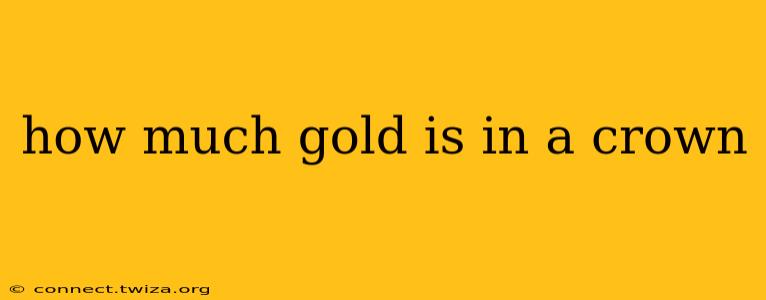How Much Gold is in a Crown? Unveiling the Royal Metal
The amount of gold in a crown is highly variable and depends on several crucial factors. There's no single answer to this question, as the quantity of gold can differ dramatically based on the crown's age, origin, purpose (ceremonial vs. everyday use), and the reigning monarch's preferences. Let's delve into the intricacies of royal regalia and explore the factors that determine a crown's gold content.
What Kind of Gold is Used in Crowns?
Crowns aren't typically made of pure, 24-karat gold. Pure gold, while beautiful, is too soft for the structural demands of a crown. Instead, crowns are usually crafted from alloys, blending gold with other metals like silver, copper, or even platinum to increase durability and hardness. The karatage (a measure of gold purity) will significantly influence the overall gold weight. A crown might be made from 22-karat gold (91.67% pure gold), 18-karat gold (75% pure gold), or even lower karats, depending on the desired properties and cost considerations.
How Much Gold is in a Specific Crown? The Problem of Exact Figures.
Determining the precise gold weight of a particular crown is challenging. While some historical records might detail the materials used, these records are not always complete or accessible. Furthermore, many crowns have undergone repairs or alterations over the centuries, making precise measurements even more difficult. The composition may also vary across different parts of the crown.
How is the Gold Content Determined?
To accurately determine the gold content of a crown, sophisticated analysis methods would be needed. These methods might include:
- X-ray fluorescence (XRF): This non-destructive technique analyzes the elemental composition of the crown's surface without causing damage.
- Assaying: This involves taking a small sample of the metal and testing its purity using various chemical techniques.
It's important to remember that these methods are often not performed on priceless and historically significant artifacts due to potential damage risks. Therefore, precise figures are rarely publicized.
What About Modern Crowns?
Modern crowns might incorporate fewer precious metals due to cost considerations and changing aesthetics. They might instead use gold plating or incorporate less gold within more elaborate designs featuring gemstones and other materials.
What are Some Examples of Famous Crowns?
While precise gold weights are unavailable for most famous crowns, we can appreciate their craftsmanship and artistry. Consider the Imperial State Crown of the United Kingdom, known for its intricate design and numerous gemstones, or the St. Edward's Crown, used in coronation ceremonies. These are magnificent examples of goldsmithing, showcasing the artistry and skill involved in creating royal headwear, but the exact amount of gold in them remains largely undisclosed.
What Factors Influence the Cost of a Gold Crown?
The cost of a gold crown is not solely determined by the amount of gold it contains. The overall cost is a complex equation influenced by:
- The karat of gold used: Higher-karat gold is more expensive.
- The weight of the gold: More gold means a higher cost.
- The complexity of the design and craftsmanship: Intricate designs and skilled craftsmanship significantly increase the cost.
- The value of other precious materials used: Gemstones, other metals, and other ornamentation add to the cost.
- Historical significance: A crown with significant historical context will have a much higher value than a more modern piece.
In conclusion, while we cannot pinpoint the exact amount of gold in a crown without access to specific testing and documentation, the factors outlined above provide a comprehensive understanding of the variables that contribute to the quantity and value of this precious metal in royal headwear. The fascination with royal crowns extends far beyond the mere weight of gold, encompassing their rich history, cultural significance, and exquisite craftsmanship.
